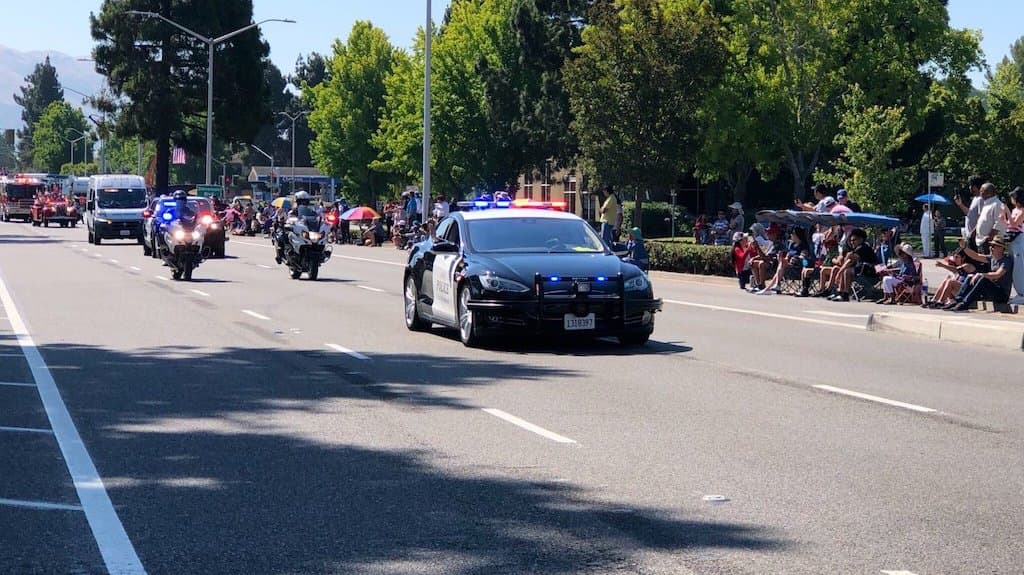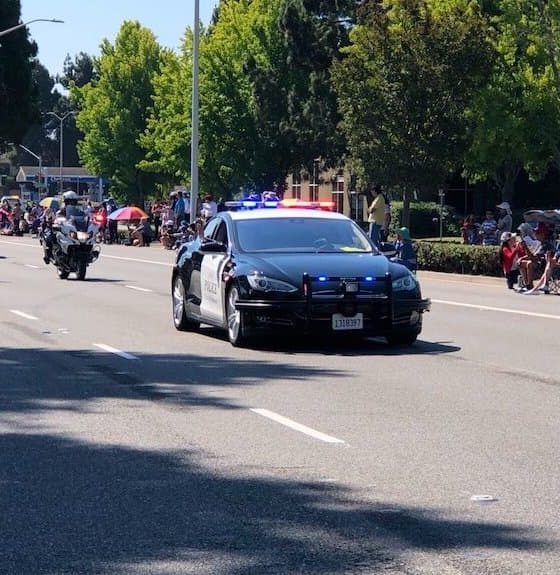

News
Tesla Model S police cruiser aces pilot program with remarkably short downtime
Last year, the Fremont Police Department launched a one-year Electric Patrol Vehicle Pilot Program aimed at determining if EVs could be effectively used as a standard police cruiser. The Fremont PD chose a second-hand Tesla Model S 85 for its program, which was outfitted with the necessary equipment and deployed as a pursuit vehicle for regular police use.
As it turned out, EVs like the Tesla Model S could not only perform well and withstand the rigors of police work; they could be on the road far longer than their gas-powered counterparts as well, thanks to their low maintenance. The department summed up its findings in a statement released on Thursday.
“After careful review, the Pilot Program was determined to be a success. The police patrol electric vehicle met the needs of police services,” the Fremont PD wrote in a report. Captain Sean Washington proved optimistic about the program as well. “The final results from the one-year Electric Patrol Vehicle Pilot Program have been encouraging as the City of Fremont continues to look for cost-effective ways to help make Fremont more sustainable,” he said.
What really set the Model S apart from its gas-powered colleagues was its low operating costs. During the pilot program, the all-electric sedan consumed $1,036 in energy, far lower than the Ford PPV’s $5,133, assuming that gasoline prices stood at $3 a gallon. The downtime for the Model S 85 was remarkably short as well, with the Tesla spending almost four weeks more on the road compared to its combustion engine-powered counterparts.
“With an average of 27 fewer days of downtime per year, a savings of $2,147 in the total annual cost of energy/fuel, maintenance, and repair, and no operational carbon dioxide emissions, the pilot program results have prompted Fremont PD to move forward with plans to expand its fleet of electric patrol vehicle alternatives,” the Captain said.
That being said, the repair costs for the Model S 85 proved higher at $4,865 during the pilot year as compared to the $2,915 required by the Ford PPV. According to the Fremont PD on Twitter, this was partly due to the fact that they had to replace the Model S’ tires, thanks in part to the vehicle being used on a pursuit course over multiple days to help train officers. A couple of flat tires over the year also added to the vehicle’s repair costs.
Ultimately, the Model S proved itself as a car that is more than capable of being used as a standard police vehicle. Its 265-mile range easily accommodated the 40 to 70 miles of driving that regular patrol vehicles accumulate on an average day. Police officers who used the Tesla even reported an enhanced feeling of safety and control, as well as a reduction in anxiety and stress, when using the Model S. Radio communications with the Tesla proved superior too, thanks to the lack of engine noise.
Thanks in part to the successful pilot year of the Model S 85, the Fremont Police Department has since added a Tesla Model Y to its fleet. The authorities noted that the Model Y could be even better than the Model S due to its lower starting price, longer range, increased storage space, and higher ground clearance.
The Fremont PD’s report on its Electric Patrol Vehicle Pilot Program could be accessed below.
Police Electric Vehicle Pilot by Simon Alvarez on Scribd

News
Tesla aims to combat common Full Self-Driving problem with new patent
Tesla writes in the patent that its autonomous and semi-autonomous vehicles are heavily reliant on camera systems to navigate and interact with their environment.

Tesla is aiming to combat a common Full Self-Driving problem with a new patent.
One issue with Tesla’s vision-based approach is that sunlight glare can become a troublesome element of everyday travel. Full Self-Driving is certainly an amazing technology, but there are still things Tesla is aiming to figure out with its development.
Unfortunately, it is extremely difficult to get around this issue, and even humans need ways to combat it when they’re driving, as we commonly use sunglasses or sun visors to give us better visibility.
Cameras obviously do not have these ways to fight sunglare, but a new patent Tesla recently had published aims to fight this through a “glare shield.”
Tesla writes in the patent that its autonomous and semi-autonomous vehicles are heavily reliant on camera systems to navigate and interact with their environment.

The ability to see surroundings is crucial for accurate performance, and glare is one element of interference that has yet to be confronted.
Tesla described the patent, which will utilize “a textured surface composed of an array of micro-cones, or cone-shaped formations, which serve to scatter incident light in various directions, thereby reducing glare and improving camera vision.”

The patent was first spotted by Not a Tesla App.
The design of the micro-cones is the first element of the puzzle to fight the excess glare. The patent says they are “optimized in size, angle, and orientation to minimize Total Hemispherical Reflectance (THR) and reflection penalty, enhancing the camera’s ability to accurately interpret visual data.”
Additionally, there is an electromechanical system for dynamic orientation adjustment, which will allow the micro-cones to move based on the angle of external light sources.
This is not the only thing Tesla is mulling to resolve issues with sunlight glare, as it has also worked on two other ways to combat the problem. One thing the company has discussed is a direct photon count.
CEO Elon Musk said during the Q2 Earnings Call:
“We use an approach which is direct photon count. When you see a processed image, so the image that goes from the sort of photon counter — the silicon photon counter — that then goes through a digital signal processor or image signal processor, that’s normally what happens. And then the image that you see looks all washed out, because if you point the camera at the sun, the post-processing of the photon counting washes things out.”
Future Hardware iterations, like Hardware 5 and Hardware 6, could also integrate better solutions for the sunglare issue, such as neutral density filters or heated lenses, aiming to solve glare more effectively.
Elon Musk
Delaware Supreme Court reinstates Elon Musk’s 2018 Tesla CEO pay package
The unanimous decision criticized the prior total rescission as “improper and inequitable,” arguing that it left Musk uncompensated for six years of transformative leadership at Tesla.

The Delaware Supreme Court has overturned a lower court ruling, reinstating Elon Musk’s 2018 compensation package originally valued at $56 billion but now worth approximately $139 billion due to Tesla’s soaring stock price.
The unanimous decision criticized the prior total rescission as “improper and inequitable,” arguing that it left Musk uncompensated for six years of transformative leadership at Tesla. Musk quickly celebrated the outcome on X, stating that he felt “vindicated.” He also shared his gratitude to TSLA shareholders.
Delaware Supreme Court makes a decision
In a 49-page ruling Friday, the Delaware Supreme Court reversed Chancellor Kathaleen McCormick’s 2024 decision that voided the 2018 package over alleged board conflicts and inadequate shareholder disclosures. The high court acknowledged varying views on liability but agreed rescission was excessive, stating it “leaves Musk uncompensated for his time and efforts over a period of six years.”
The 2018 plan granted Musk options on about 304 million shares upon hitting aggressive milestones, all of which were achieved ahead of time. Shareholders overwhelmingly approved it initially in 2018 and ratified it once again in 2024 after the Delaware lower court struck it down. The case against Musk’s 2018 pay package was filed by plaintiff Richard Tornetta, who held just nine shares when the compensation plan was approved.
A hard-fought victory
As noted in a Reuters report, Tesla’s win avoids a potential $26 billion earnings hit from replacing the award at current prices. Tesla, now Texas-incorporated, had hedged with interim plans, including a November 2025 shareholder-approved package potentially worth $878 billion tied to Robotaxi and Optimus goals and other extremely aggressive operational milestones.
The saga surrounding Elon Musk’s 2018 pay package ultimately damaged Delaware’s corporate appeal, prompting a number of high-profile firms, such as Dropbox, Roblox, Trade Desk, and Coinbase, to follow Tesla’s exodus out of the state. What added more fuel to the issue was the fact that Tornetta’s legal team, following the lower court’s 2024 decision, demanded a fee request of more than $5.1 billion worth of TSLA stock, which was equal to an hourly rate of over $200,000.
Delaware Supreme Court Elon Musk 2018 Pay Package by Simon Alvarez
News
Tesla Cybercab tests are going on overdrive with production-ready units
Tesla is ramping its real-world tests of the Cybercab, with multiple sightings of the vehicle being reported across social media this week.

Tesla is ramping its real-world tests of the Cybercab, with multiple sightings of the autonomous two-seater being reported across social media this week. Based on videos of the vehicle that have been shared online, it appears that Cybercab tests are underway across multiple states.
Recent Cybercab sightings
Reports of Cybercab tests have ramped this week, with a vehicle that looked like a production-ready prototype being spotted at Apple’s Visitor Center in California. The vehicle in this sighting was interesting as it was equipped with a steering wheel. The vehicle also featured some changes to the design of its brake lights.
The Cybercab was also filmed testing at the Fremont factory’s test track, which also seemed to involve a vehicle that looked production-ready. This also seemed to be the case for a Cybercab that was spotted in Austin, Texas, which happened to be undergoing real-world tests. Overall, these sightings suggest that Cybercab testing is fully underway, and the vehicle is really moving towards production.
Production design all but finalized?
Recently, a near-production-ready Cybercab was showcased at Tesla’s Santana Row showroom in San Jose. The vehicle was equipped with frameless windows, dual windshield wipers, powered butterfly door struts, an extended front splitter, an updated lightbar, new wheel covers, and a license plate bracket. Interior updates include redesigned dash/door panels, refined seats with center cupholders, updated carpet, and what appeared to be improved legroom.
There seems to be a pretty good chance that the Cybercab’s design has been all but finalized, at least considering Elon Musk’s comments at the 2025 Annual Shareholder Meeting. During the event, Musk confirmed that the vehicle will enter production around April 2026, and its production targets will be quite ambitious.








